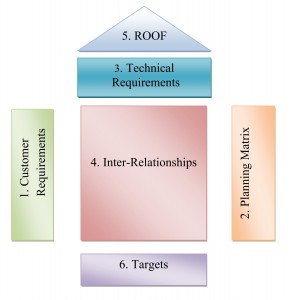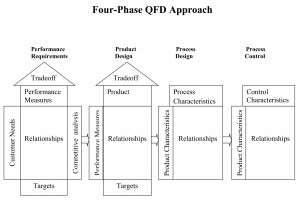iv. Inter-relationships
This section forms the main body of the House of Quality matrix .The centre of the matrix describes the relation between customer requirements and design requirements. This illustrates the QFD team’s perceptions of interrelationships between technical and customer requirements. An appropriate scale is applied, illustrated using symbols or figures. Filling this portion of the matrix involves discussions and consensus building within the team and can be time consuming. Concentrating on key relationships and minimising the requirements are useful techniques to reduce the demands on resources.
v. Roof
The top most part or the triangular roof of the matrix represents the fifth phase (inter-relationships between the technical descriptors). This is used to identify where technical requirements support or impede each other in the product design. Can highlight innovation opportunities.
vi. Targets
The bottom of the matrix indicates the targets. It is used to record the priorities assigned to technical requirements by the matrix, measures of technical performance achieved by competitive products and the degree of difficulty involved in developing each requirement. The final output of the matrix is a set of target values for each technical requirement to be met by the new design. These are linked back to the customers’ demands.This is the final section and summaries the conclusions drawn from the data contained in the entire matrix and the team’s discussions.
It is generally made up from three parts:
a) Technical Priorities
The relative importance of each technical requirements of the products in meeting the customer,s specified needs,can be simply calculated from the weightings contained in the planning and interrelationship matrix sections.Each interrelationship weighting is multiplied by the Overall Weighting from the Planning matrix.These values are then summed down the columns to give a priority score for each technical requirement.
b) Competitive benchmarks
Each of the technical requirements that have been identified as important characteristics of the product can be measured both for the company’s own existing product and helps to identify the targetlevels of performance to be achieved in a new product.
c) Targets
The final output of the HOQ matrix is set of engineering target values to be met by the new product design.The process of building this matrix enables these target to be set and prioritized based on an understanding of the customer need,the competition’s performance and the organisation’s current performance.The QFD team now need to draw on all this information when deciding on these values.
The “House of Quality” can be used as a stand-alone tool to generate answers to a particular development problem. Alternatively it can be applied within a more complex system in which a series of tools are applied for each stage of the product/service development. The outputs of the first stage give the product/ service design specifications (the Hows). These in turn form the inputs (or whats) for the second stage of development. This sequence repeats at every stage and the outputs of the fifth and final phase are the production requirements for the product/service.
Phase 2, Product Design
This phase 2 is led by the engineering department. Product design requires creativity and innovative team ideas. Product concepts are created during this phase and part specifications are documented. Parts that are determined to be most important to meeting customer needs are then deployed into process planning, or Phase 3.
Phase 3, Process Planning
Process planning comes next and is led by manufacturing engineering. During process planning, manufacturing processes are flowcharted and process parameters (or target values) are documented.
Phase 4, Process Control
And finally, in production planning, performance indicators are created to monitor the production process, maintenance schedules, and skills training for operators. Also, in this phase decisions are made as to which process poses the most risk and controls are put in place to prevent failures. The quality assurance department in concert with manufacturing leads Phase 4.



